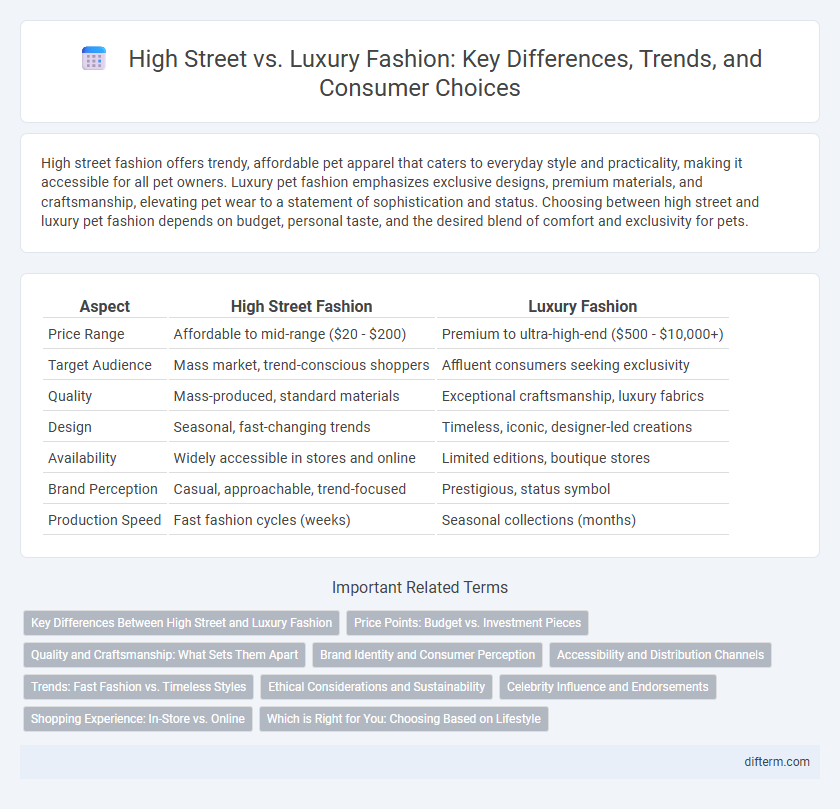High street fashion offers trendy, affordable pet apparel that caters to everyday style and practicality, making it accessible for all pet owners. Luxury pet fashion emphasizes exclusive designs, premium materials, and craftsmanship, elevating pet wear to a statement of sophistication and status. Choosing between high street and luxury pet fashion depends on budget, personal taste, and the desired blend of comfort and exclusivity for pets.
Table of Comparison
| Aspect | High Street Fashion | Luxury Fashion |
|---|---|---|
| Price Range | Affordable to mid-range ($20 - $200) | Premium to ultra-high-end ($500 - $10,000+) |
| Target Audience | Mass market, trend-conscious shoppers | Affluent consumers seeking exclusivity |
| Quality | Mass-produced, standard materials | Exceptional craftsmanship, luxury fabrics |
| Design | Seasonal, fast-changing trends | Timeless, iconic, designer-led creations |
| Availability | Widely accessible in stores and online | Limited editions, boutique stores |
| Brand Perception | Casual, approachable, trend-focused | Prestigious, status symbol |
| Production Speed | Fast fashion cycles (weeks) | Seasonal collections (months) |
Key Differences Between High Street and Luxury Fashion
High street fashion emphasizes affordability, fast production cycles, and trend-driven designs aimed at mass-market appeal, while luxury fashion prioritizes exclusivity, superior craftsmanship, and high-quality materials targeting affluent consumers. High street brands often rely on rapid inventory turnover and widespread accessibility, contrasting with luxury brands' limited editions and personalized service that enhance brand prestige. Price disparity is significant, with luxury items reflecting meticulous attention to detail and heritage, positioning them as investments rather than disposable garments.
Price Points: Budget vs. Investment Pieces
High street fashion offers budget-friendly price points, making trendy and accessible clothing available to a broad audience. Luxury fashion focuses on investment pieces, characterized by higher prices that reflect premium materials, craftsmanship, and timeless design. Consumers often choose high street options for frequent wardrobe updates, while luxury purchases are seen as long-term, durable additions to a refined collection.
Quality and Craftsmanship: What Sets Them Apart
High street fashion prioritizes affordability and trend-driven designs, often utilizing mass production techniques that may compromise fabric quality and detailed craftsmanship. Luxury fashion emphasizes superior materials, meticulous handcrafting, and timeless construction, resulting in garments that offer durability and distinctive elegance. The investment in artisanal skills and premium textiles distinguishes luxury apparel from the more accessible but less durable high street options.
Brand Identity and Consumer Perception
High street fashion brands emphasize affordability and trend responsiveness, fostering a brand identity centered on accessibility and mass appeal, which shapes consumer perception as practical and trendy choices. Luxury fashion brands cultivate exclusivity, heritage, and craftsmanship, positioning themselves as symbols of status and timeless elegance that attract consumers seeking quality and prestige. The contrast in brand identity directly influences consumer perception, with high street appealing to value-driven shoppers and luxury targeting aspirational customers valuing uniqueness and superior quality.
Accessibility and Distribution Channels
High street fashion brands dominate accessibility through widespread distribution channels such as flagship stores, online platforms, and major retail chains, making trendy apparel affordable and available to a large audience globally. Luxury fashion relies on exclusive boutiques, limited online presence, and personalized shopping experiences to maintain brand prestige and appeal to affluent consumers. The contrast in distribution strategies underscores the difference in market reach and consumer engagement between high street and luxury fashion sectors.
Trends: Fast Fashion vs. Timeless Styles
High street fashion thrives on fast fashion trends, rapidly producing affordable and trendy pieces that respond quickly to seasonal changes and consumer demand. Luxury fashion emphasizes timeless styles, investing in high-quality materials and craftsmanship that ensure durability and lasting appeal beyond fleeting trends. The contrast highlights consumer preferences for immediate, budget-friendly options versus enduring, sophisticated wardrobe staples.
Ethical Considerations and Sustainability
High street fashion often relies on mass production techniques that raise ethical concerns such as labor exploitation and environmental degradation, while luxury fashion brands prioritize sustainable sourcing, artisanal craftsmanship, and transparency in their supply chains. The fast fashion industry's carbon footprint and waste generation contrast sharply with luxury labels' investments in eco-friendly materials, circular economy initiatives, and long-term durability. Consumer demand increasingly favors brands embracing ethical labor practices and sustainability certifications, influencing the industry's shift towards more responsible fashion consumption.
Celebrity Influence and Endorsements
Celebrity influence significantly drives consumer preferences in both high street and luxury fashion, with stars often endorsing high street brands to create accessible trends while simultaneously elevating luxury labels through exclusive collaborations. High street brands capitalize on celebrity endorsements to boost mass-market appeal, leveraging social media platforms where influencers showcase affordable styles. Luxury fashion relies on celebrity endorsements to reinforce brand prestige and exclusivity, frequently featuring celebrities in high-profile events and campaigns that highlight craftsmanship and heritage.
Shopping Experience: In-Store vs. Online
High street fashion offers a fast, accessible shopping experience with frequent new arrivals and affordable prices accessible both in-store and online, appealing to trend-driven consumers seeking convenience. Luxury fashion emphasizes personalized, immersive in-store experiences with expert consultations, exclusive collections, and opulent settings that create a sense of exclusivity not fully replicable online. Online luxury shopping integrates virtual try-ons, high-definition imagery, and curated selections to enhance convenience while preserving brand prestige and customer engagement.
Which is Right for You: Choosing Based on Lifestyle
High street fashion offers affordable, trendy pieces that cater to fast-paced, budget-conscious lifestyles, making it ideal for those seeking variety and frequent wardrobe updates. Luxury fashion prioritizes quality, exclusivity, and timeless designs, appealing to individuals who value craftsmanship and long-term investment in their style. Choosing between high street and luxury fashion depends on personal priorities such as budget, lifestyle demands, and preference for sustainability or exclusivity.
high street vs luxury fashion Infographic

 difterm.com
difterm.com